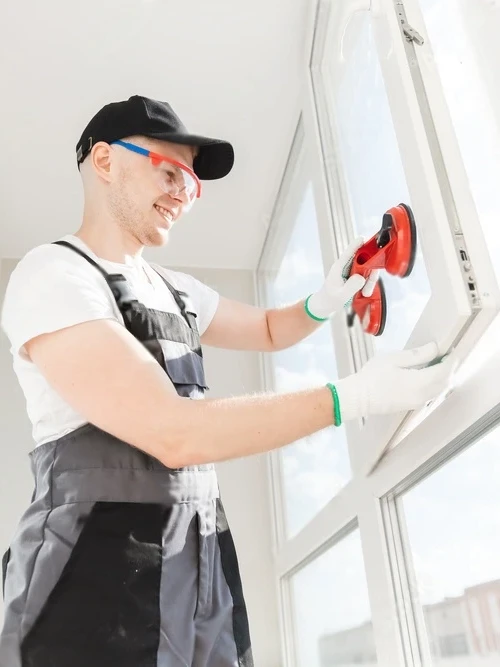Double glazing and window frames are essential components in modern home construction and renovation in the United Kingdom. They play a crucial role in enhancing a home’s energy efficiency, security, and overall comfort. This article delves into the world of double glazing, exploring its benefits, types, and considerations for selection and maintenance.
Considering replacement windows?
Key Takeaways:
- Double Glazing Benefits: Improved energy efficiency, noise reduction, enhanced security, and cost savings.
- Types of Double-Glazed Windows: Various styles and materials, including wood and composite frames.
- Selection and Maintenance: Key factors in choosing the right windows and tips for maintenance.
Introduction to Double Glazing
Double glazing involves the use of two panes of glass in a window frame, separated by a space filled with gas or air. This design significantly improves a building’s insulation properties. Originating in the Victorian era, double glazing has evolved into a standard feature in UK homes, primarily due to its energy-saving capabilities.

Benefits of Double Glazing
Energy Efficiency and Insulation
Double-glazed windows are renowned for their energy efficiency. They provide an excellent barrier against external temperatures, helping maintain a comfortable indoor climate. This insulation capability is measured in terms of U-value, with lower values indicating better insulation.
Noise Reduction
For those living in busy urban areas or near airports, the noise reduction offered by double glazing is invaluable. The two layers of glass and the intervening space effectively dampen external noise, creating a quieter, more peaceful home environment.
Enhanced Security
Security is a paramount concern for homeowners. Double-glazed windows are tougher to break compared to single-pane windows, offering an added layer of security against break-ins.
Long-term Cost Savings
Although the initial investment might be higher, double-glazed windows can lead to significant savings on energy bills. By reducing the need for heating and cooling, these windows can pay for themselves over time.
Types of Double-Glazed Windows
Different Styles and Designs
Double-glazed windows come in various styles, including casement, sash, and tilt-and-turn windows, each offering different benefits in terms of aesthetics and functionality.
Frame Materials
The choice of window frame material impacts the window’s durability, maintenance, and appearance. Popular options in the UK include:
- Wood Frames: Classic and elegant, but require more maintenance.
- Composite Frames: A blend of materials offering durability and low maintenance.
Glass Types and Their Properties
The type of glass used in double glazing also varies. Options include:
- Low-E Glass: Minimizes UV and infrared light without reducing light transmission.
- Toughened Glass: Offers enhanced safety and security.
Selecting the Right Double-Glazed Windows
When choosing double-glazed windows, several factors should be considered to ensure you select the best option for your home.

Factors to Consider
- Material: The frame material affects the window’s look, feel, and longevity.
- Size and Style: The window size and style should complement the architectural design of your home.
- Cost: Prices vary based on material, size, and additional features like acoustic insulation or solar gain control.
Understanding the Cost
The cost of double-glazed windows in the UK can range significantly. Several factors influence this cost, including:
- Frame Material: Wood frames tend to be more expensive than uPVC window frames or composite frames.
- Glass Type: Specialty glasses like low-E or toughened glass can add to the cost.
- Installation: Professional installation ensures optimal performance but adds to the overall cost.
Tips for Choosing Windows
- Consider the architectural style of your home.
- Evaluate the U-value for energy efficiency.
- Balance aesthetics with functionality and budget.
Installation and Maintenance
Proper installation and maintenance are key to maximizing the benefits of double-glazed windows.
DIY vs. Professional Installation
While DIY installation might seem cost-effective, professional installation guarantees correct fitting and optimal performance. It’s advisable to hire experienced professionals, especially for complex window styles.
Maintenance Tips
Regular maintenance ensures the longevity and efficiency of double-glazed windows. Tips include:
- Regular cleaning of both panes.
- Checking and replacing seals if necessary.
- Inspecting for condensation between panes, which indicates a broken seal.
Common Issues and Troubleshooting
Issues like condensation, drafts, or difficulty in opening and closing windows should be addressed promptly to maintain the window’s functionality.
Cost Factors
When investing in double-glazed windows, understanding the cost factors is crucial. Here’s a breakdown of what influences the price:
| Factor | Description |
| Material | Wood, uPVC, and composite frames vary in price. |
| Glass Type | Specialty glasses like low-E or toughened glass can increase costs. |
| Size & Style | Larger windows and unique styles can be more expensive. |
Installation Considerations
Proper installation is key to the performance of double-glazed windows. It’s advisable to compare quotes and check the credentials of installers before making a decision.

Maintenance and Troubleshooting
Regular maintenance extends the life of your windows and ensures they function effectively.
Maintenance Checklist
| Task | Frequency |
| Cleaning | Bi-annually |
| Seal Inspection | Annually |
| Hardware Check | Annually |
Troubleshooting Common Issues
- Condensation Inside Panes: Indicates seal failure, requiring professional repair.
- Drafts: Often due to sealant issues or frame damage.
- Difficulty in Opening/Closing: Usually related to hardware or frame warping.
FAQs on Double Glazing and Window Frames
Double-glazed windows typically last between 20 to 35 years, depending on the quality of materials and installation, as well as maintenance practices.
Yes, by providing better insulation, double-glazed windows can significantly reduce heating and cooling costs, making them a cost-effective choice in the long run.
Eco-friendly options include frames made from sustainable materials and glasses that offer high energy efficiency.
Signs include noticeable drafts, difficulty in operation, and condensation between panes.
Yes, common issues like sealant failure or glass damage can often be repaired without needing to replace the entire window.







